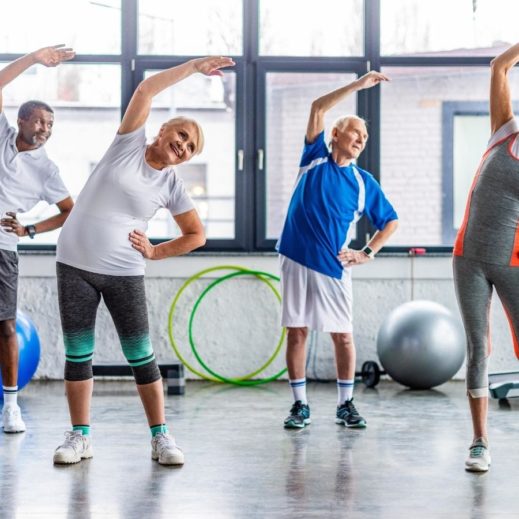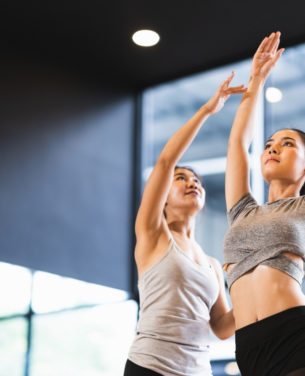Equilibrium
by Circuit

How to Meet Weekly Strength and Cardio Recommendations for a Balanced Fitness Routine
26.11.2021
Does your weekly fitness routine include a healthy mix of strength, endurance, flexibility and balance? According to the National Institute of Health, these four components are the key to maximizing your protection against injury by providing different benefits and preventing adaptive resistance, which occurs due to repeated an exercise over a long period of time, resulting in your body no longer being able to respond to it. Having a well-balanced fitness routine is also a key to preventing workout boredom by inspiring you to stay on track with new challenges and regular variety so you don’t feel like you are doing the same static movements all the time.
To compliment the four components of strength, balance, flexibility, and endurance, recommended fitness guidelines suggest adults achieve a mixture of 150 minutes per week of moderate-intensity aerobic activity, or 75 minutes per week of vigorous aerobic activity, or a combination of both throughout the week. In addition to the aerobic activity, it’s suggested that adults include strength-training activities of moderate intensity or higher that involve all major muscle groups for at least 2 days per week. The elderly should perform additional balance training and fall prevention exercises for a minimum of 3 times per week.
First, we’ll dive into the various types of movements you should include weekly to maximize your benefit, and why they are important. Next, we’ll cover different ways to maximize the recommended strength-training and cardio requirements each week, and finally, we’ll discuss various fitness routines to help you meet these goals and benefit from a well-rounded weekly fitness routine.
Strength
Strength is so important to include in your weekly routine, since it’s been shown that muscle deterioration begins at a rate of 3-8% each decade starting around the age of 30. The involuntary muscle mass decrease impairs strength and function, and is a leading cause in disabilities that occur with age. The decrease in muscle mass is also accompanied by a progressive increase in fat, and therefore influences body composition, which can lead to increased incidence of insulin resistance in the elderly. Bone density is also decreased due to the reduction in muscle mass, leading to symptoms such as joint stiffness, reductions in posture, and change to skeletal frame over time. For more chronic health issues such as type 2 diabetes, obesity, heart disease, and osteoporosis, this can further implicate the need to boost strength-training wherever possible.
The most obvious way to include strength-training into your routine is by weight-lifting, however working with resistance bands and performing bodyweight exercises can also help. You can slowly build up your strength with light weights or try stretchy, lower resistance bands to start off with, increasing your weight or resistance with time, or whenever you can do two sets of 10-15 repetitions easily. Aim to do strength-training exercises for all major muscle groups at least 2 days a week, but try to also avoid working out the same muscle group for 2 consecutive days in a row.
Simple ways to include strength-training include gripping a tennis ball, lifting groceries, doing wall or table push-ups, and lifting your body weight. Safety tips include caution against holding your breath for too long, exhaling as you lift and inhaling as you relax.
Balance
Balance exercises are critical in movements we perform as part of our everyday life, including walking up and down stairs, reaching for objects, and even maintaining a good posture. Balance exercises are especially critical in preventing falls and injuries for elderly adults and stroke patients. With obesity, balance plays a role in improving the mobility that is impaired from the lack of proper weight distribution throughout the body.
Common practices and workouts that can help you achieve better balance in your everyday life include Yoga, Tai Chi, and more simple movements such as standing on one foot, heel-to-toe walks, balance walks, and standing from a seated position. Recommended safety tips include having a chair, wall, or person to spot you nearby to help you from falling over.

Flexibility
Flexibility also helps to promote balance, support strength-training, increase physical performance through easier range of motion, improve muscle weakness, reduce injuries, and provide relief for back pain and other limitations. Flexibility is primarily improved through stretching. It helps you to move easier for simple movements such as looking over your shoulder, bending down to pick something up, or reaching high up as just a few examples.
Yoga and Pilates are two of the best ways to improve flexibility by lengthening muscle fibers and increasing tolerance for stretched tissues. For elderly or anyone with compromised ability to perform a full routine, simple and basic exercises include the back stretch exercise, inner thigh stretch, ankle stretch, and back of leg stretch. Safety tips for flexibility include stretching when your muscles are warmed up, stretching after endurance or strength exercises, never stretching to a point of pain, and breathing regularly while stretching.
Endurance
Endurance is the final component that helps round out and benefit your weekly fitness routine. Endurance exercises go as far as improving your heart health, circulation, and lungs, and they also play a role in delaying and preventing chronic health issues including diabetes, heart disease, as well as some of the most common cancers such as breast and colon cancer.
Many cardio exercises help to increase and improve endurance, as well as activities including swimming, jogging, dancing, stair climbing, brisk walking, playing soccer or basketball, and even yard work. Avoiding sitting for longer periods of time and getting in swift and brief movements whenever possible such as taking the stairs when available can help you boost your cardio and endurance. Safety tips for endurance movements include warming up your body with light activity prior, as well as staying hydrated, dressing in layers to allow for easy removal of clothes in the event of overheating, and listening to your body if you feel any signs of chest pain, extreme fatigue, or dizziness.

Tips for getting the recommended weekly cardio and strength-training
There is no one-size-fits-all for getting your recommended cardio and strength-training movements in every week, but a variety of fitness classes and movements can help you incorporate all the necessary components to maximize your fitness. To start with the recommended 50 minutes of moderate-intensity or 75 minutes of vigorous-intensity aerobic physical activity each week, you can try breaking it up in small bursts each day or through the week. Moderate intensity means that while you are doing that activity, you should be able to say a few words in a row but not sing, while vigorous intensity means that while you are doing that activity, you won’t be able to say more than a few words without stopping for a breath. Aerobic activities include anything cardio-related to get the blood pumping, and this can include jogging, walking, running, swimming, biking, or group fitness classes such as cycle, HIIT or Circuit Training that pump up the heart rate. A Vinyasa Yoga Class, while not designated cardio, is a great way to warm-up the body and get the blood pumping before a more intense cardio sprint.
For strength-training, moderate to high-intensity movements can be achieved through resistance bands, weights, or weight-bearing activities. This is recommended two times a week, and not in consecutive time frames.
Group fitness classes that blend strength, cardio, flexibility and balance
As part of our virtual fitness programming with Circuit, we offer several different types of fitness to help promote not only strength-training through bodyweight, but flexibility, balance, and endurance. Here are some of the highlights:
Strength-training, balance, and and endurance (cardio) group fitness classes:
Bodyweight Bootcamp: This interval-training style class mixes calisthenics and body weight exercises with cardio and strength training for participants looking for an extra challenge. Routines vary each week to keep the body guessing.
Power Hour: This workout creates focus among the upper body and lower body with different approaches each week for toning and stretching large muscle groups.
Ab Blast: This brief yet challenging workout targets the abs, back, and midsection to build a strong core and promote balance, posture, and overall strength.
Strength & Tone: This routine includes body weight, core, and resistance training movements for the full body that elevate the heart rate with minimum joint impact while activating the breath for relaxation. (This class also helps promote flexibility)
Balance, Flexibility, and Moderate Strengthening group fitness classes:
Hatha Yoga: This class includes basic postures to help align, strengthen, and promote flexibility in the body. You can expect an emphasis on simple repetition and ease of movement as a foundation to build your yoga practice.
Pilates: This routine uses movements like planks, side planks, and core exercises to enhance your muscles and core strength.
Vinyasa Yoga: This Vinyasa Yoga class with a twist uses different approaches to movement in a fun, dynamic way. Whether it’s exploring a pose to fit your body or building strength and fluidity through warming flows, the sequences allow you to tune into self-awareness.
Yoga Core: This foundational yoga includes strengthening, grounding, and core development on a deeper level. Standing poses and balance asanas are included along with breath work and mindfulness activation.
Are you interested in bringing a variety of in-person fitness where you live to help promote a variety of ? If so, contact us to get started on a plan for the community you live in today.


